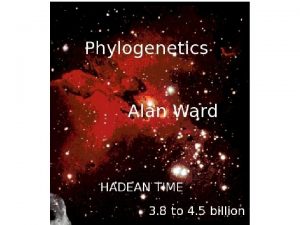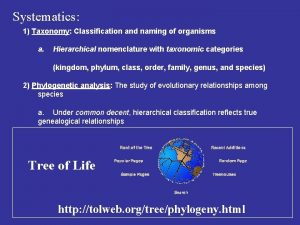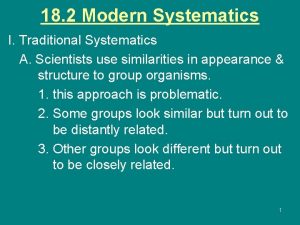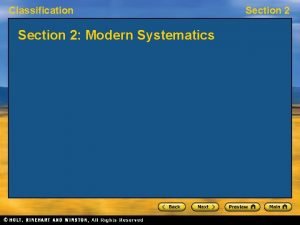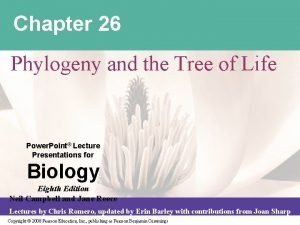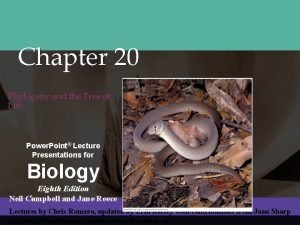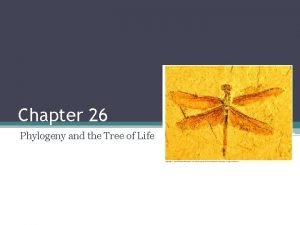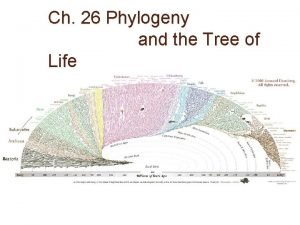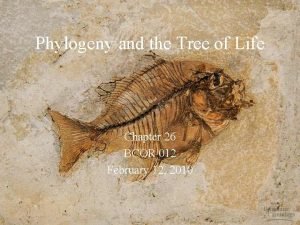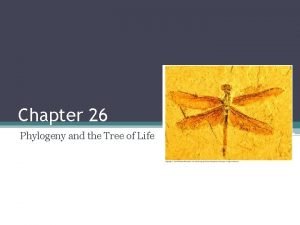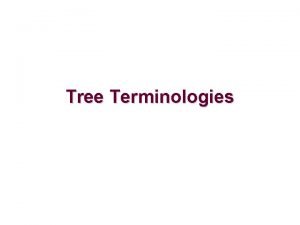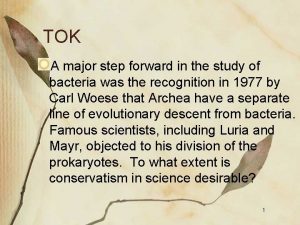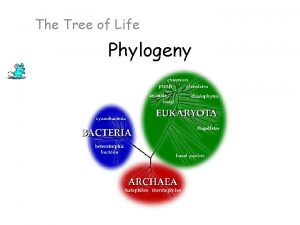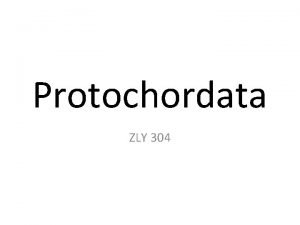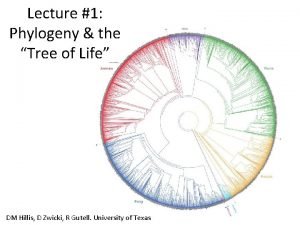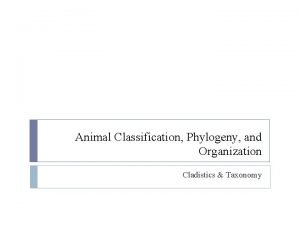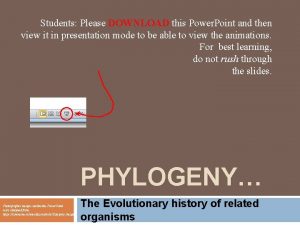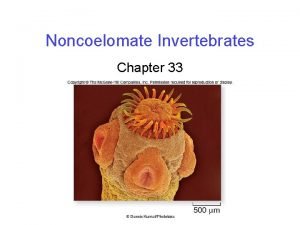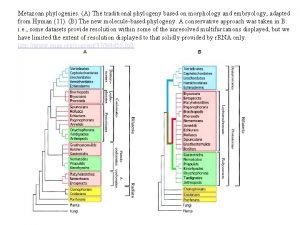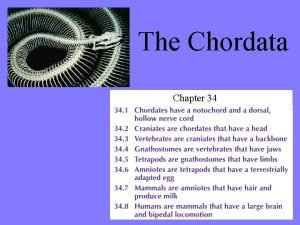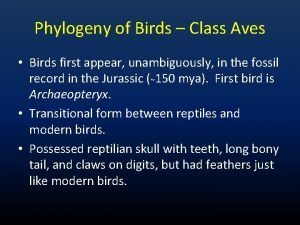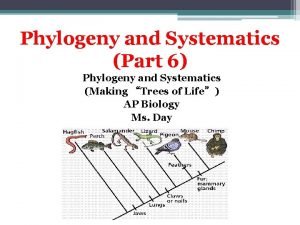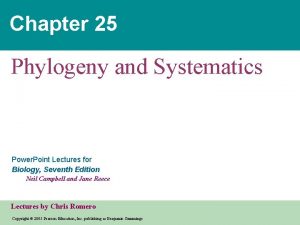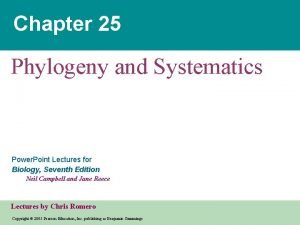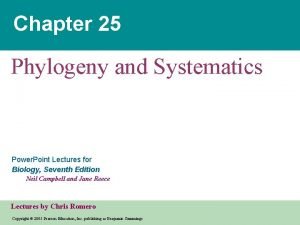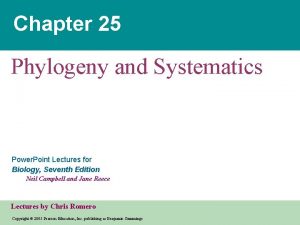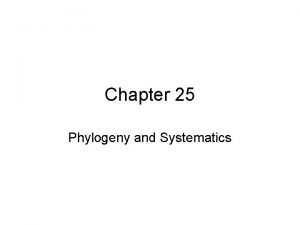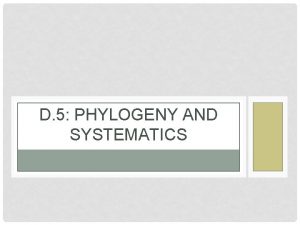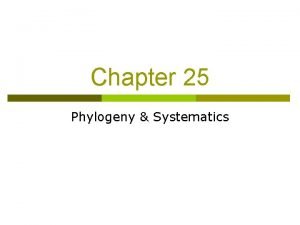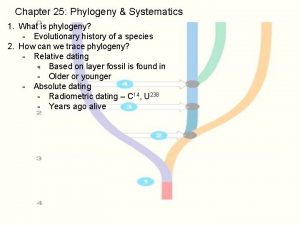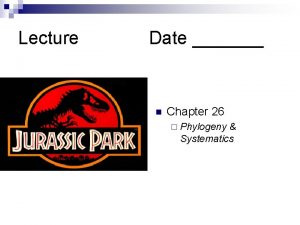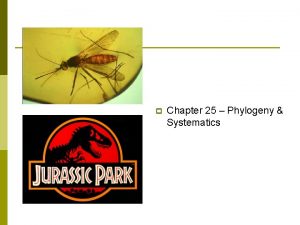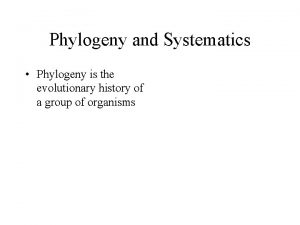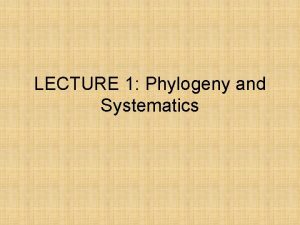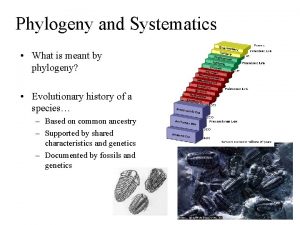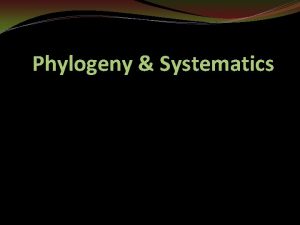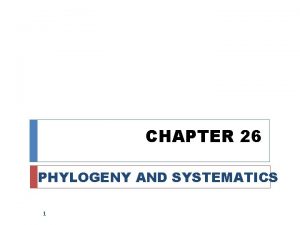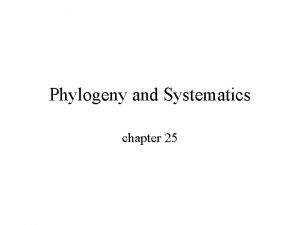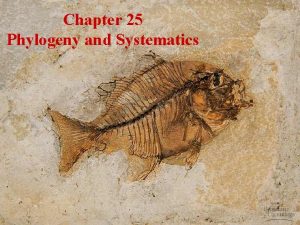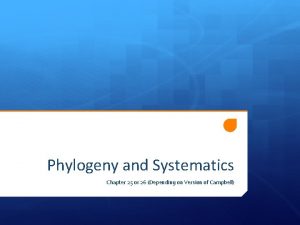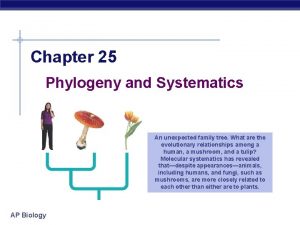Chapter 25 Phylogeny and Systematics Power Point Lectures
































- Slides: 32

Chapter 25 Phylogeny and Systematics Power. Point Lectures for Biology, Seventh Edition Neil Campbell and Jane Reece Lectures by Chris Romero Copyright © 2005 Pearson Education, Inc. publishing as Benjamin Cummings

• Overview: Investigating the Tree of Life • This chapter describes how biologists trace phylogeny – The evolutionary history of a species or group of related species Copyright © 2005 Pearson Education, Inc. publishing as Benjamin Cummings

• Biologists draw on the fossil record – Which provides information about ancient organisms Figure 25. 1 Copyright © 2005 Pearson Education, Inc. publishing as Benjamin Cummings

• Currently, systematists use – Morphological, biochemical, and molecular comparisons to infer evolutionary relationships Figure 25. 2 Copyright © 2005 Pearson Education, Inc. publishing as Benjamin Cummings

• Concept 25. 1: Phylogenies are based on common ancestries inferred from fossil, morphological, and molecular evidence Copyright © 2005 Pearson Education, Inc. publishing as Benjamin Cummings

The Fossil Record • Sedimentary rocks – Are the richest source of fossils – Are deposited into layers called strata 1 Rivers carry sediment to the ocean. Sedimentary rock layers containing fossils form on the ocean floor. 2 Over time, new strata are deposited, containing fossils from each time period. 3 As sea levels change and the seafloor is pushed upward, sedimentary rocks are exposed. Erosion reveals strata and fossils. Younger stratum ���with more recent fossils Figure 25. 3 Older stratum with older fossils Copyright © 2005 Pearson Education, Inc. publishing as Benjamin Cummings

• The fossil record – Is based on the sequence in which fossils have accumulated in such strata • Fossils reveal – Ancestral characteristics that may have been lost over time Copyright © 2005 Pearson Education, Inc. publishing as Benjamin Cummings

• Though sedimentary fossils are the most common – Paleontologists study a wide variety of fossils (c) Leaf fossil, about 40 million years old (b) Petrified tree in Arizona, about 190 million years old (a) Dinosaur bones being excavated from sandstone (d) Casts of ammonites, about 375 million years old (f) Insects preserved whole in amber Figure 25. 4 a–g (g) Tusks of a 23, 000 -year-old mammoth, frozen whole in Siberian ice Copyright © 2005 Pearson Education, Inc. publishing as Benjamin Cummings (e) Boy standing in a 150 -million-year-old dinosaur track in Colorado

Morphological and Molecular Homologies • In addition to fossil organisms – Phylogenetic history can be inferred from certain morphological and molecular similarities among living organisms • In general, organisms that share very similar morphologies or similar DNA sequences – Are likely to be more closely related than organisms with vastly different structures or sequences Copyright © 2005 Pearson Education, Inc. publishing as Benjamin Cummings

• Convergent evolution occurs when similar environmental pressures and natural selection – Produce similar (analogous) adaptations in organisms from different evolutionary lineages Figure 25. 5 Copyright © 2005 Pearson Education, Inc. publishing as Benjamin Cummings

• Analogous structures or molecular sequences that evolved independently – Are also called homoplasies Copyright © 2005 Pearson Education, Inc. publishing as Benjamin Cummings

Evaluating Molecular Homologies • Systematists use computer programs and mathematical tools – When analyzing comparable DNA segments from different organisms 1 Ancestral homologous DNA segments are identical as species 1 and species 2 begin to diverge from their common ancestor. 1 C C A T C A G T C C 2 C C A T C A G T C C Deletion 2 3 4 Figure 25. 6 Deletion and insertion mutations shift what had been matching sequences in the two species. Homologous regions (yellow) do not all align because of these mutations. Homologous regions realign after a computer program adds gaps in sequence 1. 1 C C A T C A G T C C 2 C C A T C A G T C C G T A Insertion 1 C C A T C A 2 C C A T G T A 1 2 A G T C C A T G T A C A G T C C C A G T C C Copyright © 2005 Pearson Education, Inc. publishing as Benjamin Cummings A C G G A T A G T C C A C T A G G C A C T A T C A C C G A C A G G T C T T T G A C T A G Figure 25. 7

• Concept 25. 2: Phylogenetic systematics connects classification with evolutionary history • Taxonomy – Is the ordered division of organisms into categories based on a set of characteristics used to assess similarities and differences Copyright © 2005 Pearson Education, Inc. publishing as Benjamin Cummings

Binomial Nomenclature • Binomial nomenclature – Is the two-part format of the scientific name of an organism – Was developed by Carolus Linnaeus Copyright © 2005 Pearson Education, Inc. publishing as Benjamin Cummings

• The binomial name of an organism or scientific epithet – Is latinized – Is the genus and species Copyright © 2005 Pearson Education, Inc. publishing as Benjamin Cummings

Hierarchical Classification • Linnaeus also introduced a system – For grouping species in increasingly broad categories Panthera Species pardus Panthera Genus Felidae Family Carnivora Order Class Phylum Kingdom Figure 25. 8 Domain Copyright © 2005 Pearson Education, Inc. publishing as Benjamin Cummings Mammalia Chordata Animalia Eukarya

Linking Classification and Phylogeny • Systematists depict evolutionary relationships Species Panthera Order Family Panthera Mephitis Canis Lutra lutra pardus mephitis familiaris lupus (European (leopard) (striped skunk) otter) (domestic dog) (wolf) Genus – In branching phylogenetic trees Mephitis Felidae Lutra Mustelidae Carnivora Figure 25. 9 Copyright © 2005 Pearson Education, Inc. publishing as Benjamin Cummings Canidae

• Each branch point – Represents the divergence of two species Leopard Domestic cat Common ancestor Copyright © 2005 Pearson Education, Inc. publishing as Benjamin Cummings

• “Deeper” branch points – Represent progressively greater amounts of divergence Wolf Leopard Common ancestor Copyright © 2005 Pearson Education, Inc. publishing as Benjamin Cummings Domestic cat

• Concept 25. 3: Phylogenetic systematics informs the construction of phylogenetic trees based on shared characteristics • A cladogram – Is a depiction of patterns of shared characteristics among taxa • A clade within a cladogram – Is defined as a group of species that includes an ancestral species and all its descendants • Cladistics – Is the study of resemblances among clades Copyright © 2005 Pearson Education, Inc. publishing as Benjamin Cummings

Shared Primitive and Shared Derived Characteristics • In cladistic analysis – Clades are defined by their evolutionary novelties Copyright © 2005 Pearson Education, Inc. publishing as Benjamin Cummings

• A shared primitive character – Is a homologous structure that predates the branching of a particular clade from other members of that clade – Is shared beyond the taxon we are trying to define Copyright © 2005 Pearson Education, Inc. publishing as Benjamin Cummings

• A shared derived character – Is an evolutionary novelty unique to a particular clade Copyright © 2005 Pearson Education, Inc. publishing as Benjamin Cummings

• Applying parsimony to a problem in molecular systematics Human 0 Mushroom Tulip 30% 0 Tulip Figure 25. 14 (a) Percentage differences between sequences Copyright © 2005 Pearson Education, Inc. publishing as Benjamin Cummings 40% 0

• Applying parsimony to a problem in molecular systematics 25% 15% 15% 20% 10% 5% 5% Tree 1: More likely Figure 25. 14 (b) Comparison of possible trees Copyright © 2005 Pearson Education, Inc. publishing as Benjamin Cummings Tree 2: Less likely

• The principle of maximum likelihood – States that, given certain rules about how DNA changes over time, a tree can be found that reflects the most likely sequence of evolutionary events APPLICATION In considering possible phylogenies for a group of species, systematists compare molecular data for the species. The most efficient way to study the various phylogenetic hypotheses is to begin by first considering the most parsimonious—that is, which hypothesis requires the fewest total evolutionary events (molecular changes) to have occurred. TECHNIQUE 1 Follow the numbered steps as we apply the principle of parsimony to a hypothetical phylogenetic problem involving four closely related bird species. First, draw the possible phylogenies for the species (only 3 of the 15 possible trees relating these four species are shown here). Species I I II I IV Species III Species II II I IV II IV Three possible phylogenetic hypothese 1 2 Tabulate the molecular data for the species (in this simplified example, the data represent a DNA sequence consisting of just seven nucleotide bases). Species Figure 25. 15 a 3 Now focus on site 1 in the DNA sequence. A single basechange event, marked by the crossbar in the branch leading to species I, is sufficient to account for the site 1 data. Copyright © 2005 Pearson Education, Inc. publishing as Benjamin Cummings Sites in DNA sequence 2 5 6 3 4 7 I A G G G T II G G G A A T A A G III G A G G IV G G A G I A II G III G G Base-change event IV G G G Bases at site 1 for each species III

Gene Duplications and Gene Families • Gene duplication – Is one of the most important types of mutation in evolution because it increases the number of genes in the genome, providing further opportunities for evolutionary changes Copyright © 2005 Pearson Education, Inc. publishing as Benjamin Cummings

• Orthologous genes – Are genes found in a single copy in the genome – Can diverge only once speciation has taken place Ancestral gene Speciation (a) Figure 25. 17 a Orthologous genes Copyright © 2005 Pearson Education, Inc. publishing as Benjamin Cummings

• Paralogous genes – Result from gene duplication, so they are found in more than one copy in the genome – Can diverge within the clade that carries them, often adding new functions Ancestral gene Gene duplication Figure 25. 17 b (b) Paralogous genes Copyright © 2005 Pearson Education, Inc. publishing as Benjamin Cummings

Genome Evolution • Orthologous genes are widespread – And extend across many widely varied species • The widespread consistency in total gene number in organisms of varying complexity – Indicates that genes in complex organisms are extremely versatile and that each gene can perform many functions Copyright © 2005 Pearson Education, Inc. publishing as Benjamin Cummings

Molecular Clocks • The molecular clock – Is a yardstick for measuring the absolute time of evolutionary change based on the observation that some genes and other regions of genomes appear to evolve at constant rates Copyright © 2005 Pearson Education, Inc. publishing as Benjamin Cummings

• The End Copyright © 2005 Pearson Education, Inc. publishing as Benjamin Cummings
 Systematics vs taxonomy
Systematics vs taxonomy Taxonomy vs systematics
Taxonomy vs systematics Traditional systematics
Traditional systematics Systematics deals with
Systematics deals with Section 2 modern classification
Section 2 modern classification Chapter 26 phylogeny and the tree of life
Chapter 26 phylogeny and the tree of life Chapter 20 phylogeny and the tree of life
Chapter 20 phylogeny and the tree of life Monophyletic group
Monophyletic group Chapter 26 phylogeny and the tree of life
Chapter 26 phylogeny and the tree of life Phylogeny and the tree of life chapter 26
Phylogeny and the tree of life chapter 26 Chapter 26 phylogeny and the tree of life
Chapter 26 phylogeny and the tree of life Power system lectures
Power system lectures Draw the power triangle
Draw the power triangle Informsu
Informsu Point point power
Point point power Utilities and energy lecture
Utilities and energy lecture What is text linguistics
What is text linguistics Molecular biology lectures
Molecular biology lectures Sister taxon
Sister taxon Monophyletic group vs clade
Monophyletic group vs clade What is a sister group in phylogeny
What is a sister group in phylogeny Protochordates are exclusively marine and include
Protochordates are exclusively marine and include Barnacle phylogeny
Barnacle phylogeny Biology taxonomy tree
Biology taxonomy tree What is a sister group in phylogeny
What is a sister group in phylogeny Cladogram of animal kingdom
Cladogram of animal kingdom Phylogeny
Phylogeny Symplesiomorphy
Symplesiomorphy Phylogeny
Phylogeny Invertebrate phylogeny
Invertebrate phylogeny Metazoan phylogeny
Metazoan phylogeny Chordates phylogenetic tree
Chordates phylogenetic tree Avian phylogeny
Avian phylogeny
